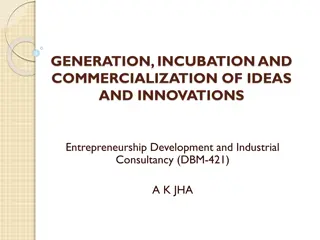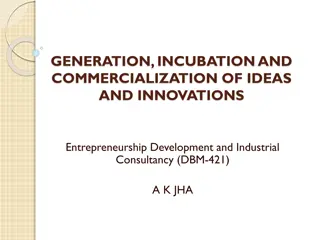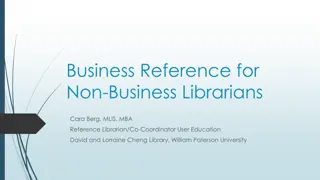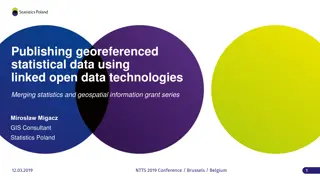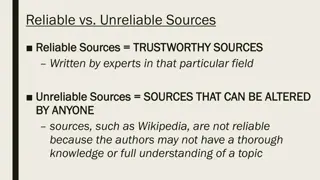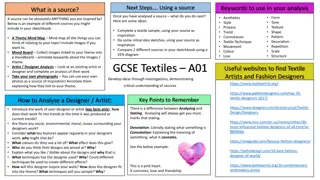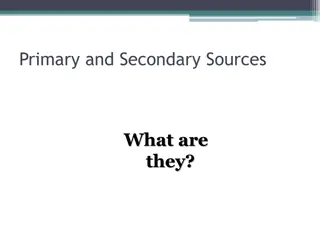Sources and Methods for Developing New Business Ideas
Explore various sources such as consumers, existing products, distribution channels, government regulations, and research and development for generating new business ideas in entrepreneurship. Additionally, learn methods like focus groups, brainstorming, and brain writing to refine and test these ideas effectively.
Download Presentation

Please find below an Image/Link to download the presentation.
The content on the website is provided AS IS for your information and personal use only. It may not be sold, licensed, or shared on other websites without obtaining consent from the author. Download presentation by click this link. If you encounter any issues during the download, it is possible that the publisher has removed the file from their server.
E N D
Presentation Transcript
Module: Social entrepreneurship and social enterprises (including green entrepreneurship)
Sources of new Ideas Idea: A thought or suggestion as to a possible course of action. Some of the more frequently used sources of ideas for entrepreneurs include; Consumers Existing product & services Distribution channels The government & Research & development
Consumers: Entrepreneurs should continually pay close attention to customers, this type of attention can take the form of informally monitoring potential ideas & needs, to formally arranging so that consumers to have an opportunity to express their opinions. New product or service idea may come from a customer reaction to the present product and from an expected product idea. It is needed to take care and ensure that the idea or need represents a market large enough to support a new venture.
Existing products & services: Entrepreneurs should also establish a formal method for monitoring & evaluating competitive products & services on the markets. This may result in a new product or service that has more of a market appeal & better sales & profit. Distribution channel: Members of the distribution channels are also excellent sources for new ideas because of their familiarity with the needs of the market. They suggest new products & also help the entrepreneurs for the marketing of their newly developed products.
The government: The government can be a source of a new product idea, as a response to government regulations. E.g. Occupational Safety & Health Act mandated that first aid kits must be available in business establishments of employing more than three people, and must contain specific items that vary according to the company. R&H Safety sales company was developing such kits that allowed companies to comply with the standards of the act. Research & development: The largest source of new ideas is the entrepreneur s own R&D efforts.
Methods of Generating New Ideas Even with such a wide variety of sources available, it can still be problematic to come up with an idea to serve as the basis for a new venture. The entrepreneur can use several methods to help generate & test new ideas, such as: Focus groups Brainstorming Brain writing & Problem inventory & analysis.
Focus groups: groups of individuals providing information in a structured format. For generating new ideas, the focus group is an excellent method for initially screening ideas & concepts. The group of 8-14 participants is stimulated by comments from each other in creatively conceptualizing & developing a new product idea to fill and fit a market need. Brainstorming: a group method for obtaining new ideas & solutions. It is based on the fact that people can be stimulated to greater creativity by meeting with others and participating in organized group experiences. The characteristics of this method are keeping criticism away; free wheeling of an idea, high quantity of ideas, combinations and improvements of ideas.
Brain writing: It is the written form of brainstorming. Brain writing is a silent, generating of ideas in a written form, by a group of people. The participants write their ideas on specific forms or cards that circulate within the group, which consists of 6 members usually. Each group member generates, and writes down three ideas during a 5 minute period, until each form has passed all participants. The leader monitors the time interval, and can reduce or lengthen the time given to participants according to the need of the group.
Problem inventory & analysis:A method for obtaining new ideas and solutions by focusing on problems. This analysis uses individuals in a manner that is analogous to focus groups in order to generate new product ideas. However, instead of generating new ideas themselves, the consumers are provided with a list of problems and then are asked to have a discussion over it, thus it ultimately results in an entirely new product idea.
Creative problem solving Creativity is the act of turning new and imaginative ideas into reality and it is an important attribute of a successful entrepreneur. On the other hand, creative problem solving is the method for obtaining new ideas focusing on the parameters. Creativity tends to decline with age, education, lack of use, and bureaucracy. Hidden creative potential can be stifled by perceptual, cultural, and organizational factors. Creativity can be unlocked by using any of the creative problem- solving techniques.
Creative problem solving techniques 1. Brainstorming: This is the first technique & is probably the most well known and widely used for both creative problem solving, as well as idea generation. A good brainstorming session starts with a problem statement that is neither too broad (that would diversify ideas and nothing specific would emerge), nor too narrow (that would tend to confine responses) Once the problem statement is prepared, 6-12 individuals are selected to participate. To avoid inhibiting responses, none of the group members should be an expert in the field of the problem. All ideas must be recorded.
2. Reverse Brainstorming: It is a group method for obtaining new ideas focusing on the negative. It is similar to brainstorming except that criticism is allowed. The main focus is on finding fault by asking questions. Hence focuses on the negative aspects of a product, service, or idea as well as ways to overcome these problems. Care must be taken to maintain group morale.
3. Gordon Method: It is the method for developing new ideas when the individuals are unaware of the problem. Unlike many other creative problem-solving techniques, begins with group members not knowing the exact nature of the problem. Entrepreneur starts by monitoring a general concept associated with the problem , the group responds by expressing a number of ideas. Then a concept is developed, followed by related concepts, through guidance of the entrepreneur. The actual problem is then revealed, enabling the group to make suggestions for implementation or refinement of the final solution.
4. Checklist Method: Developing a new idea through a list of related issues. In this method a new idea is developed through a list of related issues or suggestions. The entrepreneur can use the list of questions or statements to guide the direction of developing entirely new ideas or concentrating on specific idea areas. E.g. modify? New twist? Change, color, scent, shape. Magnify? What to add? More time? Stronger? Larger? Thicker?
5. Free association: Developing a new idea through a chain of word associations. A word or phrase related to the problem is written down, then another and another, with each new word attempting to add something new to the ongoing thought processes, thereby creating a chain of ideas ending with a new product idea emerging. 6. Collective Notebook Method Developing a new idea by group members regularly recording ideas. A small note book that easily fits in a pocket, containing a statement of the problem, blank pages and any pertinent background data is distributed. Participants consider the problem and its possible solutions, recording ideas at least once, but preferably three times a day. At the end of a week, a list of the best ideas is developed, along with any suggestions.
7. Attribute listing: Developing a new idea by looking at the positives and negatives. This method requires the entrepreneurs to list the attributes of an item or problem & then look at each from a variety of viewpoints that will result to form a new combination, and possible new uses that better meet the requirements regarding a certain need.
Opportunity Analysis Plan Each and every innovative idea should be carefully assessed by the entrepreneur. One good way to do this is the Opportunity analysis plan. While the Opportunity Analysis Plan is not a Business Plan, as it focuses on the idea and the market for that idea. It also is shorter than a business plan and does not contain a formal financial statement of the venture. A typical opportunity analysis plan has four sections: A description of the idea and its competition An assessment of the domestic and international market for the idea An assessment of the entrepreneur and the team A discussion of the steps needed to make the idea basis for a viable business venture
3 Root Cause Analysis Tools for More Effective Problem-Solving Next to defining a problem accurately, root cause analysis is one of the most important elements of problem-solving in quality management. That s because if you re not aiming at the right target, you ll never be able to eliminate the real problem that s hindering the quality. So which type of root cause analysis tool is the best one to use? Manufacturers have a range of methods ready to use, each of which is appropriate for different situations. Below we discuss the five common root cause analysis tools, including: Pareto Chart The 5 Whys Fishbone Diagram Scatter Diagram Failure Mode and Effects Analysis (FMEA)
1. Pareto Chart A Pareto chart is a histogram or bar chart combined with a line graph that groups the frequency or cost of different problems to show their relative significance. The bars show frequency in descending order, while the line shows cumulative percentage or total as you move from left to right. Pareto charts are based on Pareto s law, also called the 80/20 rule, which says that 20% of inputs drive 80% of results.
2. The 5 Why-s The 5 Whys is a method that uses a series of questions to drill down into successive layers of a problem. The basic idea is that each time you ask why, the answer becomes the basis of the next why. What is the problem? Why does the problem exist? Who is causing the problem, and who is affected by it? When did the problem first occur, or when did it become significant? How much, or to what extent, is this problem occurring?
3. Fishbone Diagram A fishbone diagram sorts possible causes into various categories that branch off from the original problem. Also called a cause-and-effect or Ishakawa diagram, a fishbone diagram may have multiple sub- causes branching off of each identified category.
10 Questions for the Financial Success of your Business 1. Keeping Score - Do you know the drivers of your business growth? 2. The Right Reports - Do you have the KPIs you need to make data- driven decisions? 3. Optimized Accounting System - Do you have a Smart Back Office? 4. Improved Cash Flow - Do you have a handle on your cash flow management? 5. Profitable Business - Do you think strategically about how your people drive the performance of your business, and as a result, the profitability?
6. Productive Employees - Are you measuring this key metric? 7. Maintaining a Budget - Do you need to review/revise? 8. The Right Clients - Should you fire any of your clients? 9. Business Goals - Do you have written goals? 10. Personal Goals - What are your priorities in life?










